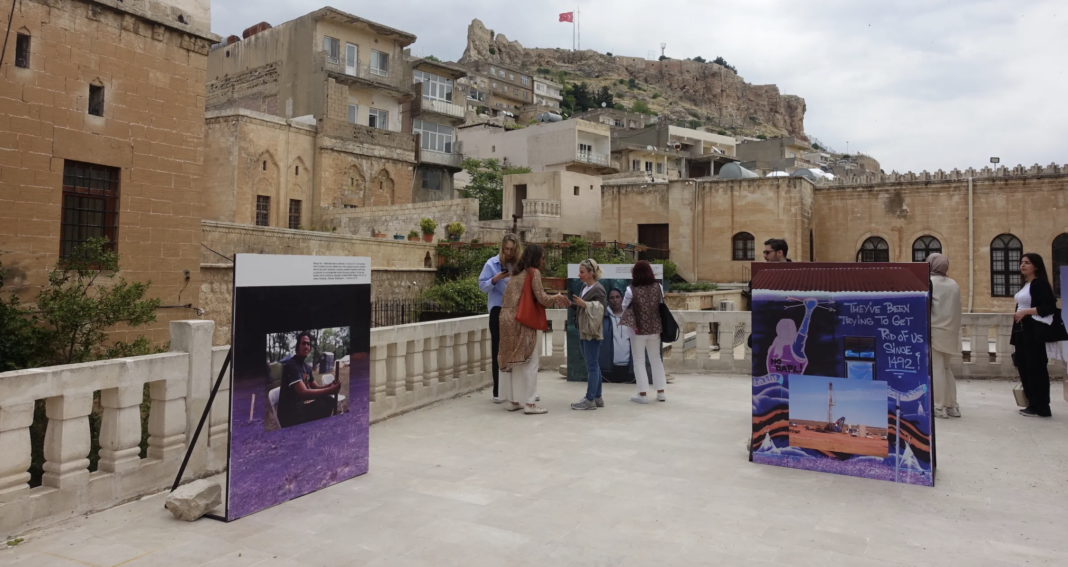Critics accuse the Mardin Biennial of exoticizing the city’s multilayered cultural heritage and ignoring the local context.
Hyperallergic, May 25, 2024, by Jennifer Hattam
As attendees mingled on the terrace of a 19th-century stone mansion during the opening of the 6th Mardin Biennial on Friday, May 10, local artist Enver Basravi moved through the crowd, passing out postcard-sized copies of the curatorial statement that included translations in Kurdish and Arabic. Both languages are widely spoken in this part of southeastern Turkey, yet are absent from the biennial’s exhibition panels and public outreach, Basravi pointed out in his accompanying text. Calling the biennial a “tourist” in the historic city, he accused the event of exoticizing Mardin’s multilayered cultural heritage.
The latest installment of the biennial, curated by Ali Akay and titled Further Away, runs through June 10. Its exhibitions installed at eight Mardin venues feature primarily Istanbul-based and international artists, a fact that rekindled concerns expressed during previous editions that the event is itself distant from the local context.
“Mardin’s protected historical places will be used only as showrooms in the biennial, where everyone except Mardin and Mardin residents will participate,” wrote local journalist Cemal Çetin just ahead of the opening. He criticized what he said was an absence of journalists, artists, and other cultural figures from Mardin invited to participate in the biennial.
The debates this year were further inflamed when a DJ playing an after-party following the opening claimed her set was cut short when a biennial corporate sponsor, objected to her playing Kurdish and Arabic music.

Organizers say the biennial, which began in 2010, is, in fact, well-integrated with the city and appreciated by its residents, especially local tradespersons with whom some participating artists collaborate on producing their works. In the event’s off-years, “people are always asking, ‘Isn’t there going to be a biennial this year?’” Mardin Biennial General Coordinator Canan Budak told Hyperallergic.
“Artists living and producing in the region also become visible to famous artists, important galleries and collectors with the exhibitions they hold in parallel with the biennial,” added Budak, who is herself a Mardin-based artist and a founding member of the independent 13m2 Art Collective.
Indeed, during the opening weekend, the city’s narrow streets were plastered with flyers for independent exhibitions, including more than two dozen shows organized under the umbrella of the newly established Hangi Sergi Nerede? (“Which Exhibition Is Where?”) digital platform. Some artists, journalists and cultural workers who came to Istanbul for the biennial said they were also making a point to visit these smaller shows, though there was no mention of them in the biennial’s promotional materials, social media posts, or press kit.

“The effects of the Mardin Biennial on the city are generally positive, but more [local] collaborations could help it make a more inclusive and sustainable contribution,” local artist Bawer Doğanay, who has an exhibition of his work running in parallel with the biennial, told Hyperallergic. His suggestions included organizing joint workshops and talks with local artists, offering mentoring programs to young artists from Mardin, and collaborating with local NGOs and locally organized cultural events.
“The biennial is lacking in some ways, and needs to be more inclusive and engage in self-critique,” added Evrim Kavcar, an artist and academic who has been teaching at the Faculty of Fine Arts at Mardin Artuklu University since 2013.
“But the fact that there are these criticisms, and these things that go wrong, means there is something actually happening here,” Kavcar told Hyperallergic. “When something is provocative and creates opposition, that is really an opportunity for deeper transformation to happen.”

